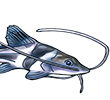Bosher, BT, SH Newton & ML Fine, 2006. The spines of the channel catfish, Ictalurus punctatus, as an anti-predator adaptation: An experimental study. Ethology 112: 188â??195.
Abstract
Although experimental evidence is lacking, the stout pectoral spine of catfishes has been interpreted as a defensive adaptation. The spine can be rigidly locked and abducted to produce stridulation sounds, which have been hypothesized to serve a warning function. We studied spine function in channel catfish (Ictalurus punctatus) as a deterrent to predation by largemouth bass (Micropterus salmoides) by presenting individuals with pairs of catfish, one with its pectoral spines clipped and the other intact. The number of initial attacks on clipped and intact fish was similar, suggesting that bass do not recognize the spine visually. Bass showed evidence of learning across trials, striking clipped fish fewer times and consuming them. Conversely, intact fish were attacked more than clipped ones because intact fish were repeatedly disgorged and attacked again, suggesting that bass become sensitized to the spine. Ingestion times were longer for intact than clipped fish, and fewer intact fish were eaten. Eighty-eight percent of intact fish survived in the mouth of a bass one or more times. Catfish did not stridulate or use their spines to deter initial attacks, refuting the warning hypothesis. Locking and stridulation motions, only observed when catfish were held inside the mouth of a bass, did not deter subsequent attacks indicating that neither the spine nor stridulation carry a warning function. It is possible, therefore, that stridulation sounds function as a distress call. The spine functions against a gape-limited predator by increasing the difficulty of ingestion but not capture.
Catfish spines as defense
- Silurus
- Posts: 12420
- Joined: 31 Dec 2002, 11:35
- I've donated: $12.00!
- My articles: 55
- My images: 893
- My catfish: 1
- My cats species list: 90 (i:1, k:0)
- Spotted: 424
- Location 1: Singapore
- Location 2: Moderator Emeritus
Silurus,
A very, very interesting study. I've often wondered about the very thing. Of course, south of the border . . .
I quote Innes in describing a doradid: "A larger fish picking it up as a morsel of food would receive a sensation somewhat as though it had taken up a chestnut burr into it's mouth."
In this 1953 edition of Exotic Aquarium Fishes, Innes lists scientific name for the fish was Acanthodoras spinosissimus (Eigenmann and Eigenmann). Translates to very, very spiny doras.
No wonder the doradids are such a sucessful bunch.
Dave
A very, very interesting study. I've often wondered about the very thing. Of course, south of the border . . .
I quote Innes in describing a doradid: "A larger fish picking it up as a morsel of food would receive a sensation somewhat as though it had taken up a chestnut burr into it's mouth."
In this 1953 edition of Exotic Aquarium Fishes, Innes lists scientific name for the fish was Acanthodoras spinosissimus (Eigenmann and Eigenmann). Translates to very, very spiny doras.
No wonder the doradids are such a sucessful bunch.
Dave
I dream of L-Numbers . . .
- racoll
- Posts: 5258
- Joined: 26 Jan 2004, 12:18
- My articles: 6
- My images: 182
- My catfish: 2
- My cats species list: 2 (i:2, k:0)
- My aquaria list: 1 (i:0)
- Spotted: 238
- Location 1: London
- Location 2: UK





